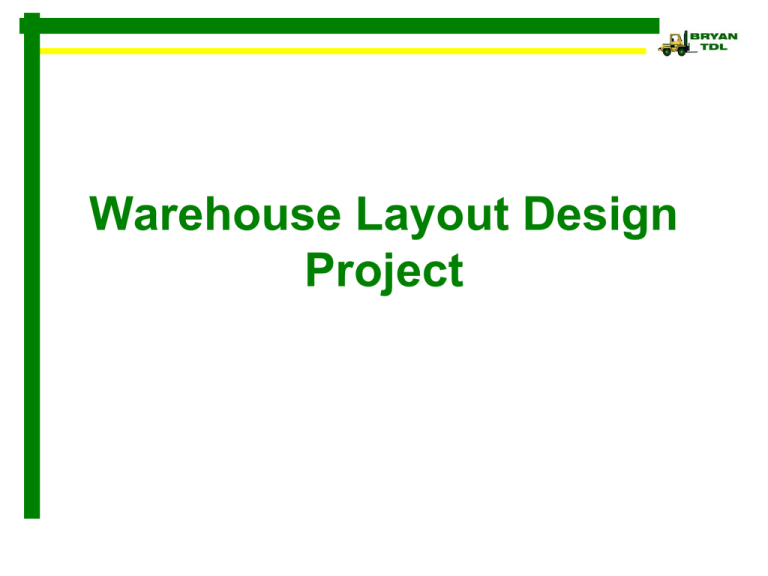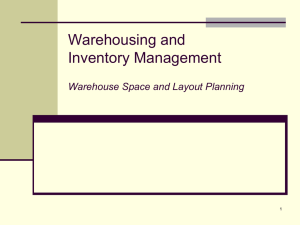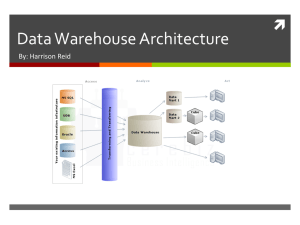Warehouse Layout - Transportation Careers
advertisement

Warehouse Layout Design Project Objective • Introduce students to the TDL Career Cluster: Warehouse and Distribution Center Operations – Storage and Distribution Manager • (Content Standard #1) • Introduce Students to Warehouse Operations • (Content Standard #3) Warehouse Operations • Warehouse: – A warehouse is a commercial building used for storage and distribution of goods. – Warehouses are used by manufacturers, importers, exporters, wholesalers, transport businesses, etc. Warehouse Layout • Warehouses must be laid out so they can function in the most efficient manner possible • Different industries have different warehouse layouts – EXAMPLE: Food warehouses may have a freezer section, cooler section, and dry foods area. Warehouse Layout • Racking and isles always runs toward the dock doors when in the same room as the dock doors. • Racking must also take in consideration any Ibeams or other obstructions. Warehouse Layout • Each section of racking is called a “bay.” • Each bay usually holds 2 or more pallets. • Racking is usually 1 to 6 bays high (depending on how much space is available in the warehouse. • Each bay usually has a label with a identification number. Warehouse Layout • Each section must have 3” on each side (front and back) free for the pallets to “hang over” the racking. – This is a OSHA Standard 3 inches for each pallet Warehouse Layout •This is an example of what happens when the racking does not have 3” on each side! •A standard pallet is usually 40” wide by 48” deep •Most pallets cannot be stacked higher than 60” Warehouse Layout • A functional design must also take into consideration the isle space (area between the racks.) • If the isle does not allow enough space for the material handling equipment (fork lifts and pallet jacks) to function properly, productivity goes down greatly. Warehouse Design Project • For this project, you will use AutoCAD to layout a floor plan for a food distribution warehouse. • You will be responsible for creating a layout that is effective and efficient. • You will also be responsible for submitting a “bid” or price tag for the racking and fork lifts included in this solution. Warehouse Constraints • The total area of this warehouse is roughly 194’ x 173’ not including walls and dock • Rooms included in the warehouse are: – 2 Dry Goods Rooms – 3 Cooler, or Refrigeration Rooms – 1 Freezer Racking Constraints • Racking measurements are as follows. • Each section will be 4 bays high • Each bay =$1,000.00 ($1,000.00 x 4 bays high = $4,000.00 per section) 3’ 6” 7’ 11” 7’ 8” 3’ Material Moving Equipment Constraints: Chose one of these fork trucks for your warehouse design. • Yale SS-BE – Isle width: 114” – $35,000.00 – 4,000-5,000 lbs • Yale NS-AF – Isle width 90” – $50,000.00 – 4,000-5,000 lbs • Yale NTA-SA – Isle width: 66” – $75,000.00 – 3,000-4,000 lbs Bid • Number of bays in your design x $1,000.00 per bay = total racking cost • Cost of fork lift you selected to go along with your design = total material handling equipment cost • Total Racking Cost + Total Material Handling Equipment Cost = Total Bid









